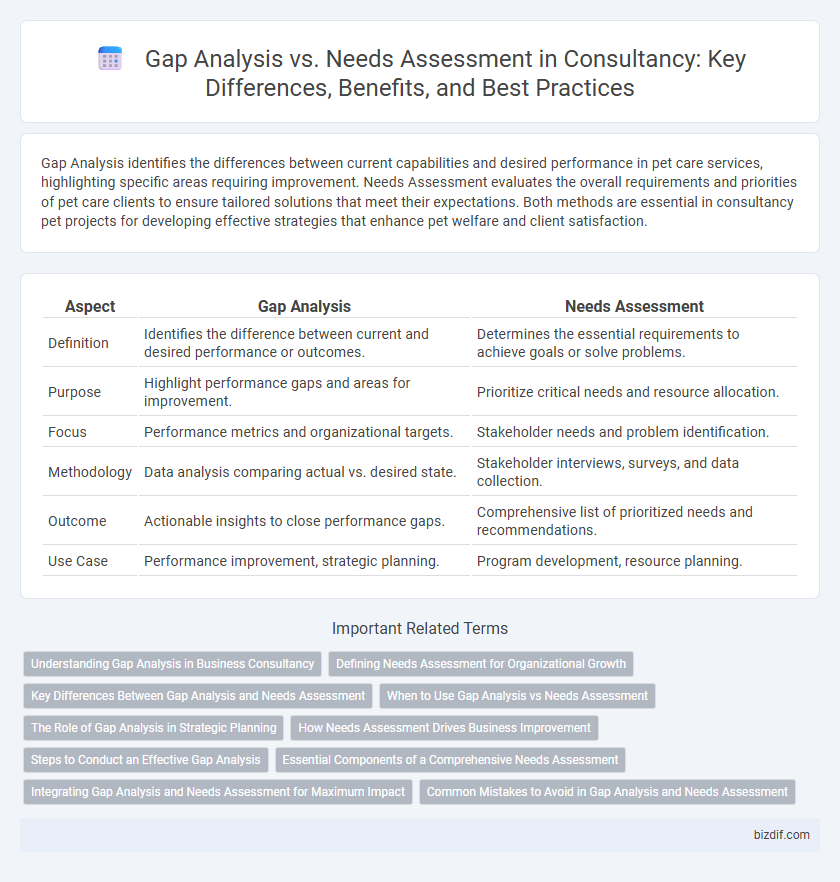Gap Analysis identifies the differences between current capabilities and desired performance in pet care services, highlighting specific areas requiring improvement. Needs Assessment evaluates the overall requirements and priorities of pet care clients to ensure tailored solutions that meet their expectations. Both methods are essential in consultancy pet projects for developing effective strategies that enhance pet welfare and client satisfaction.
Table of Comparison
| Aspect | Gap Analysis | Needs Assessment |
|---|---|---|
| Definition | Identifies the difference between current and desired performance or outcomes. | Determines the essential requirements to achieve goals or solve problems. |
| Purpose | Highlight performance gaps and areas for improvement. | Prioritize critical needs and resource allocation. |
| Focus | Performance metrics and organizational targets. | Stakeholder needs and problem identification. |
| Methodology | Data analysis comparing actual vs. desired state. | Stakeholder interviews, surveys, and data collection. |
| Outcome | Actionable insights to close performance gaps. | Comprehensive list of prioritized needs and recommendations. |
| Use Case | Performance improvement, strategic planning. | Program development, resource planning. |
Understanding Gap Analysis in Business Consultancy
Gap analysis in business consultancy identifies the discrepancies between current performance and desired objectives, enabling firms to target specific areas requiring improvement. This process involves evaluating existing processes, resources, and outcomes to develop strategic plans that bridge performance shortfalls. Effective gap analysis informs decision-making, resource allocation, and prioritizes initiatives to optimize organizational growth.
Defining Needs Assessment for Organizational Growth
Needs assessment in organizational growth identifies performance gaps by evaluating current processes, resources, and outcomes to determine specific requirements for improvement. It systematically collects and analyzes data from stakeholders to prioritize areas crucial for strategic development and resource allocation. This targeted approach ensures alignment of organizational objectives with actionable steps that drive sustainable growth.
Key Differences Between Gap Analysis and Needs Assessment
Gap analysis identifies the discrepancy between current performance and desired goals by evaluating existing processes and outcomes, while needs assessment systematically determines the specific requirements and resources necessary for achieving strategic objectives. Gap analysis focuses on performance shortfalls and areas for improvement based on measurable criteria, whereas needs assessment emphasizes understanding stakeholder priorities and resource allocation to address those gaps effectively. Both methodologies optimize organizational development but differ in scope, with gap analysis centering on performance metrics and needs assessment on comprehensive requirement identification.
When to Use Gap Analysis vs Needs Assessment
Gap analysis is best used when organizations aim to identify discrepancies between current performance and desired goals, making it ideal for strategic planning and improving operational efficiency. Needs assessment is more appropriate during the initial stages of project development or program implementation to determine essential resources, stakeholder requirements, and priority areas. Selecting between gap analysis and needs assessment depends on whether the focus is on diagnosing performance gaps or identifying foundational needs for decision-making.
The Role of Gap Analysis in Strategic Planning
Gap analysis identifies performance discrepancies between current organizational capabilities and strategic objectives, providing critical insights for prioritizing resource allocation. This process highlights specific areas where improvements or investments are necessary to achieve long-term goals, ensuring alignment with market demands and competitive benchmarks. Incorporating gap analysis into strategic planning enhances decision-making by clearly defining actionable steps for bridging performance gaps and optimizing operational efficiency.
How Needs Assessment Drives Business Improvement
Needs assessment identifies specific organizational requirements by evaluating current performance against strategic goals, enabling targeted solutions that drive business improvement. This process prioritizes resource allocation and addresses critical gaps, fostering enhanced operational efficiency and competitive advantage. Unlike gap analysis which focuses on discrepancies, needs assessment provides actionable insights for sustainable growth and innovation within consulting frameworks.
Steps to Conduct an Effective Gap Analysis
Conducting an effective gap analysis involves identifying current performance levels, defining desired future outcomes, and pinpointing the discrepancies between them. Key steps include collecting relevant data through stakeholder interviews and process reviews, analyzing this information to determine performance gaps, and prioritizing areas for improvement based on organizational goals. Implementing actionable strategies to bridge identified gaps ensures alignment with strategic objectives and optimal resource allocation.
Essential Components of a Comprehensive Needs Assessment
A comprehensive needs assessment includes identifying key stakeholders, collecting qualitative and quantitative data, and analyzing gaps between current and desired performance levels. It prioritizes needs based on impact and resource availability to develop actionable strategies. Effective needs assessments ensure alignment with organizational goals and provide a foundation for targeted interventions.
Integrating Gap Analysis and Needs Assessment for Maximum Impact
Integrating Gap Analysis and Needs Assessment enables consultancies to comprehensively identify performance shortfalls and prioritize resources effectively. Combining detailed data from Gap Analysis with targeted insights from Needs Assessment creates a strategic framework that drives actionable solutions and optimized decision-making. This integrated approach maximizes impact by aligning organizational capabilities with client requirements for sustainable growth and improved outcomes.
Common Mistakes to Avoid in Gap Analysis and Needs Assessment
Common mistakes in gap analysis include overlooking stakeholder input, resulting in incomplete data, and failing to define clear performance benchmarks, which leads to ambiguous outcomes. In needs assessment, neglecting to prioritize identified needs can dilute focus and resources, while collecting insufficient qualitative and quantitative data undermines decision-making accuracy. Avoiding these errors ensures a precise alignment between organizational goals and resource allocation.
Gap Analysis vs Needs Assessment Infographic

 bizdif.com
bizdif.com